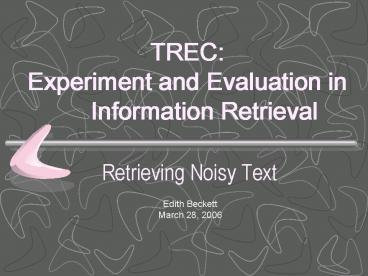TREC: Experiment and Evaluation in Information Retrieval - PowerPoint PPT Presentation
1 / 20
Title:
TREC: Experiment and Evaluation in Information Retrieval
Description:
SDR Track Design. Three types of transcripts produced from audio files: ... SDR Track Design ... SDR Results ... – PowerPoint PPT presentation
Number of Views:226
Avg rating:3.0/5.0
Title: TREC: Experiment and Evaluation in Information Retrieval
1
TREC Experiment and Evaluation
in Information Retrieval
- Retrieving Noisy Text
Edith Beckett March 28, 2006
2
Noisy Text defined
- Digital text created from non-digital sources
- Documents scanned and converted using optical
character recognition (OCR) - Transcripts created from audio sources using
automatic speech recognition (ASR) systems
3
Noisy text in TREC
- Confusion track for scanned/OCR processed texts
- Confusion track
- TREC-4 (1995)
- TREC-5 (1996)
4
Noisy text in TREC
- SDR (Spoken-document retrieval) track for the
transcribed audio/video - SDR track
- TREC-6 (1997)
- TREC-7 (1998)
- TREC-8 (1999)
- TREC-9 (2000)
5
Noisy text in TREC
- Goal was to explore methods of retrieval in
documents containing systematic errors
6
TREC-4
- Started with a baseline truth document set
- NIST created two new document sets by randomly
selecting characters to be deleted, substituted
or added
7
TREC-4
- Result a document set with a 10 percent error
rate (10 percent of the characters were changed)
and another with a 20 percent error rate - Strength did not model any particular
error-producing process - Weakness in practice, errors created by OCR
programs are systematic rather than random
8
TREC-5
- Document set was approximately 55,600 documents
from the Federal Register - Truth version was typesetting files provided
by GPO - 2nd version obtained by scanning hard copy (est.
error rate of 5 percent) - 3rd version was obtained by down sampling the
original hard copy files and re-scanning (est.
error rate of 20 percent)
9
TREC-5
- Performed known-item searches
- Two approaches
- Expand query to include or match corrupted forms
in documents - Clarify corrupted texts
10
TREC-5
- In general, retrieval results become less
effective as the noise in documents increases - Redundancy of natural language texts also
minimizes the negative effects of noisy text on
information retrieval.
11
TREC-5
- In TREC-5, lack of redundancy in artificially
created noisy documents may have contributed to
the degradation of retrieval results
12
SDR Track Design
- Three types of transcripts produced from audio
files - Reference a perfect human-produced
transcript - Baseline a common transcript produced by a
single, selected ASR system - Speech a transcript produced by an ASR system
of the participants choosing
13
SDR Track Design
- Retrieval runs used the same topics and were
required to use completely automatic processing - Providing common boundaries allowed the use of
traditional IR document-based evaluation paradigm
14
SDR Track Design
- Number of topics, length of recordings, and
number of stories increased in successive tracks - TREC-6 known-item retrieval
- TREC-7 ad hoc retrieval
- TREC-8 ad hoc retrieval
- TREC-9 ad hoc retrieval
15
TREC-6
- Demonstrated that speech recognition and IR
technologies were advanced enough to retrieve
specific documents - Factors in transcribed speech other than
recognition effects influence retrieval
effectiveness - Missing vocabulary can also cause problems
16
TREC-7
- Set of 23 topics and 2,866 stories was too small
to allow confidence in conclusions
17
TREC-8
- Same conditions as TREC-7, but document set
increased to 49 topics and 21,754 stories - Used rolling language model
- Added story-boundaries unknown condition
18
TREC-9
- Confirmation of findings from TREC-8
- Systems could find relevant passages on
unsegmented news broadcasts - Comparable performance on reference, baseline,
and speech transcripts
19
SDR Results
- Successful systems were a combination of good
retrieval technology applied to one-best word
transcripts
20
Conclusion
- With appropriate compensation, retrieval from
noisy texts can be as effective as retrieval from
clean texts































